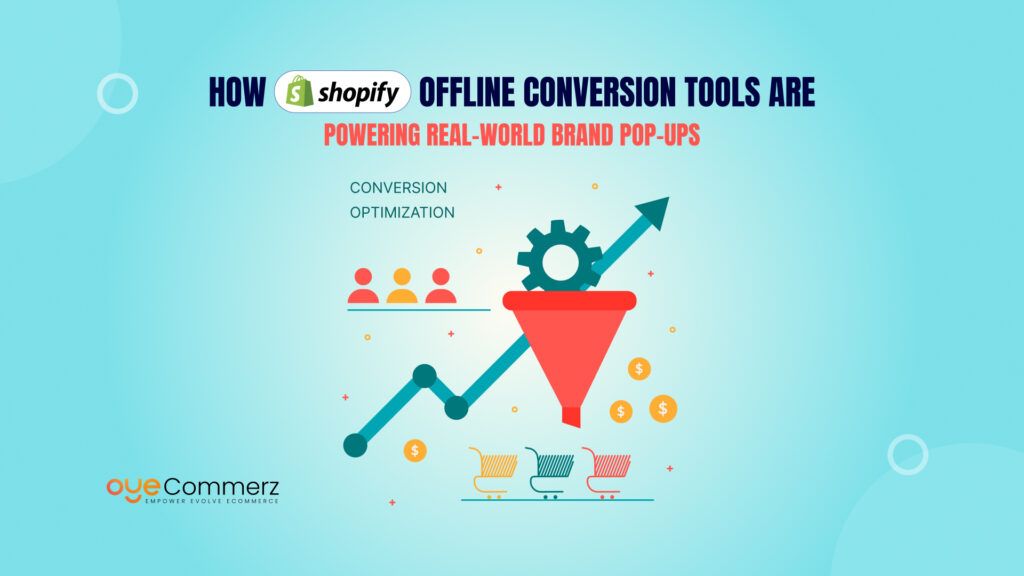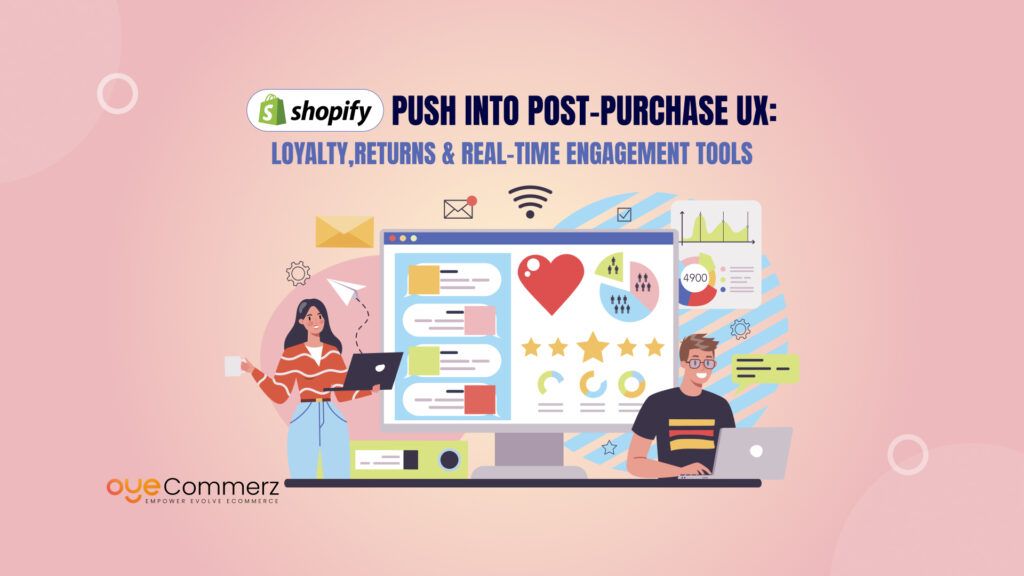Is your Shopify store truly optimized for success, or is it merely a collection of keywords hoping to catch Google’s attention?
In the digital marketplace, visibility is paramount. According to Statista, Google commands a staggering 90% share of the global search engine market, underscoring the critical role of search engines in driving online traffic.
Shopify’s user-friendly interface and robust SEO capabilities make it an attractive platform for eCommerce entrepreneurs. However, this accessibility can lead to the temptation of over-optimization, where stores are built around keywords rather than customer needs.
While a keyword-first store creation approach might seem like a shortcut to SEO success, it carries significant risks. Overemphasis on keywords can result in poor user experience, diluted brand identity, and ultimately, lower conversion rates.
In this blog, we’ll delve into the potential pitfalls of a keyword-centric strategy, explore Shopify-specific challenges, and provide actionable insights on balancing SEO with user-centric design and product-market fit.
What Is Keyword-First Store Creation in a Shopify Context?
Keyword-First Store Creation refers to the process of building a Shopify store by prioritizing search engine keywords over actual products or user needs. Instead of letting product-market fit lead the design, many merchants reverse-engineer their Shopify site structure based on search demand.
It often starts innocently, merchants use keyword research tools to find high-volume search terms, then shape their collections, URLs, and tags around those phrases.
Why this happens:
- Shopify makes it easy to customize collection pages, tags, and URLs.
- Tools like Shopify’s built-in SEO settings, plugins, and clean themes simplify on-page optimization.
- With limited products or a dropshipping model, sellers may feel pressured to “fill in” content with keywords.
However, here’s the risk:
- Designing around search intent without actual product depth leads to stores that rank, but don’t convert.
- You build pages for bots, not buyers. This means users land on a category page, but find mismatched or irrelevant products.
- Over-optimized sites may initially see traffic boosts but suffer from high bounce rates and poor retention.
There’s a fine line between a smart Shopify SEO strategy and blindly chasing search traffic.
So while the platform gives unmatched flexibility, it also opens the door for misused optimizations. The rest of this blog explores how to stay on the right side of that line, balancing discoverability with genuine user experience.
The Shopify Temptation: Why Keyword-First Seems Like a Smart Move
On the surface, Keyword-First Store Creation seems like the logical first step, especially when trying to compete in crowded niches. After all, if 68% of online journeys start with a search engine, why not build your store around what people are already looking for?
Why sellers buy into it:
- Shopify SEO strategy consultants often suggest early keyword mapping to fast-track rankings.
- Shopify themes are SEO-friendly, and it’s easy to set up collections using keyword-based filters or tags.
- Creating blog content around those same keywords gives you a quick boost in topical authority.
Why it feels scalable:
- Especially for general or dropshipping stores, SEO-led structures give the illusion of depth.
- You can appear relevant for multiple niches without building true product authority.
- Proper internal linking and category saturation can mimic brand strength in Google’s eyes.
But while all of this can boost visibility quickly, sustainability becomes a concern.
Here’s where things get tricky:
- Google’s algorithms are getting better at detecting value vs. noise.
- Real users don’t care about your H1s, they care about relevance and trust.
- Fast SEO wins don’t always translate into long-term growth or conversions.
The Shopify platform is powerful, but that power must be channeled thoughtfully. Over-relying on keyword-first logic creates a brittle foundation. You need real substance behind every SEO-led collection or blog.
So while keyword-first strategies can drive initial visibility, they can’t be your entire Shopify SEO strategy if you want a store that lasts.
How Shopify Sellers Are Misusing Keyword-First Strategy
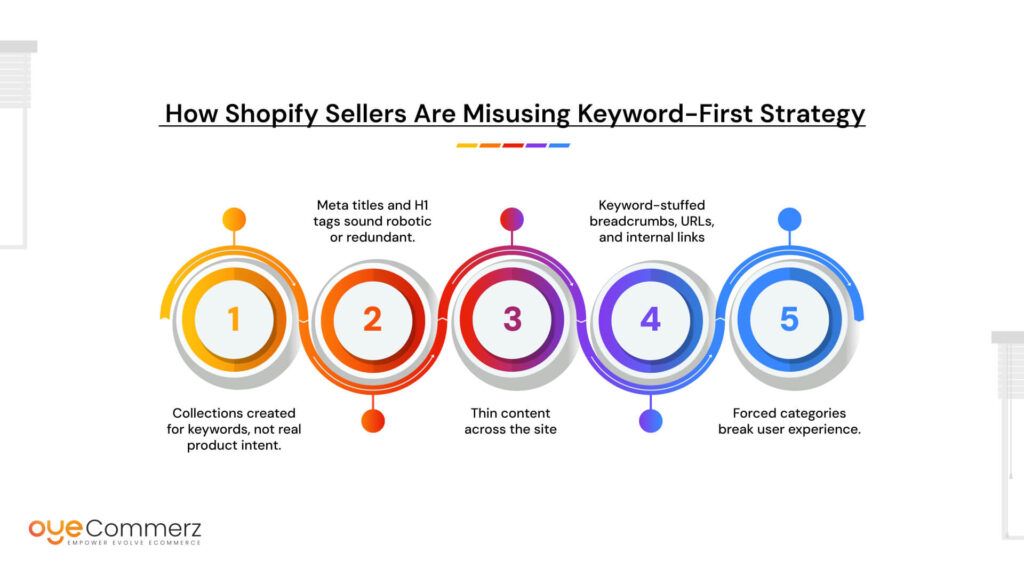
Despite the appeal of Keyword-First Store Creation, many Shopify sellers are falling into avoidable traps by over-prioritizing keywords and neglecting customer experience.
Common missteps:
Collections created for keywords, not real product intent.
Example: A seller has a niche product but creates a collection called “best men’s watches under $200” even though their products don’t match that term’s nuance.
Meta titles and H1 tags sound robotic or redundant.
Repeating phrases like “Buy Stylish Red Shoes – Stylish Red Shoes Online – Stylish Red Shoes USA” across multiple pages may appease bots temporarily, but alienates readers.
Thin content across the site.
Product descriptions stuffed with keywords instead of benefits, specs, or emotional triggers undercut trust and fail to drive conversions.
Keyword-stuffed breadcrumbs, URLs, and internal links.
Over-optimized URLs like /cheap-blue-tooth-earbuds-wireless-2024 may rank, but they hurt CTRs due to lack of clarity and flow.
Forced categories break user experience.
When every product has to fit a keyword category, users get confused by unrelated or repeated product listings.
These issues are compounded when sellers rely on AI-generated content without human refinement. Google’s helpful content updates target exactly these kinds of patterns—thin, duplicative, keyword-stuffed pages built purely for search visibility.
The core issue? Sellers are executing a Shopify SEO strategy that ignores how real people shop.
Rather than thinking of SEO as a front-loaded checklist, successful brands use it as a way to match real needs. They blend keyword intent with brand storytelling, product value, and smooth navigation.
Keyword-First Store Creation doesn’t have to be a trap, but right now, many Shopify sellers are walking straight into one. The damage isn’t just lower rankings, it’s lower trust, fewer repeat customers, and stagnating growth.
The Hidden SEO and UX Damage on Shopify
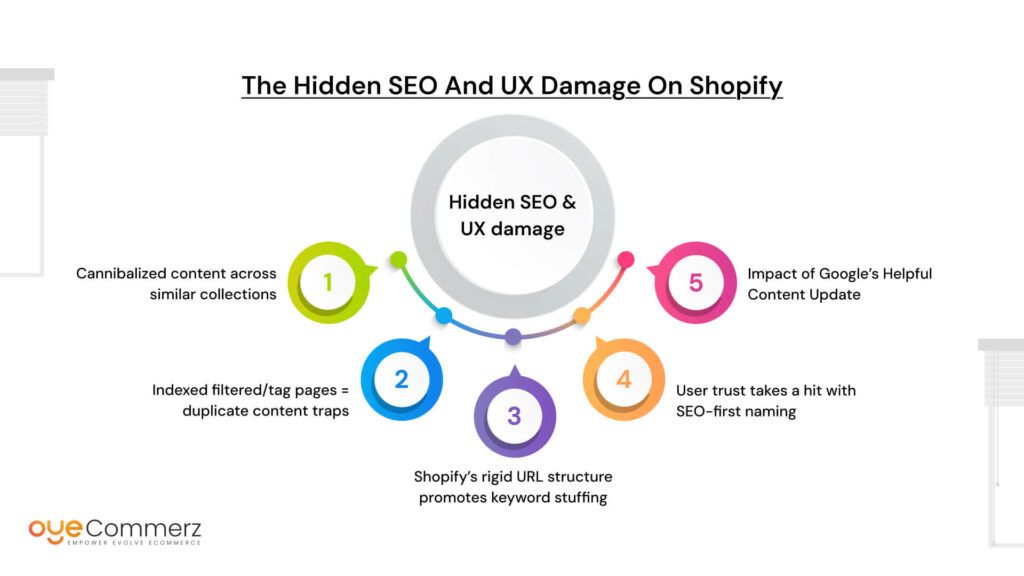
At first glance, Keyword-First Store Creation looks like a smart SEO tactic. But under the surface, it can sabotage both user experience and long-term search visibility, especially on a platform like Shopify.
Shopify’s native flexibility makes it easy to create endless collections and filtered views. But without a strategy grounded in product intent and hierarchy, these features start backfiring.
Here’s where damage creeps in:
Cannibalized content across similar collections
When multiple collections are created around variations of the same keyword, for example, “Men’s Sneakers,” “Affordable Men’s Sneakers,” and “Best Sneakers for Men”, they start competing against each other in the SERPs.
- Google struggles to decide which to rank.
- You dilute authority across pages instead of building it into one comprehensive hub.
- Shopify’s lack of advanced canonical controls adds to the confusion.
Indexed filtered/tag pages = duplicate content traps
By default, Shopify allows tag-based pages (e.g., /collections/shirts/red) to be indexed. These pages often have no original content and mirror the parent collection.
- This leads to hundreds of low-value URLs in Google’s index.
- Duplicate content reduces crawl budget efficiency.
- It’s a silent killer for growing stores that add filters rapidly.
Shopify’s rigid URL structure promotes keyword stuffing
Example: /collections/buy-modern-bright-led-kitchen-light-online-usa
Not only is this unnatural and visually clunky, but it also signals over-optimization. Shopify doesn’t let you remove “/collections/” or restructure folders without apps or workarounds, forcing users to cram terms into slugs.
User trust takes a hit with SEO-first naming
Names like “Buy Waterproof Red Jacket Men USA Online” erode brand credibility. Customers can sense when a title is written for Google, not for them.
Impact of Google’s Helpful Content Update
Launched to reward human-first, value-driven content, this update specifically penalizes sites that:
- Create content primarily for search engines
- Provide minimal real insight or product differentiation
- Use repetitive patterns and over-optimized headings across pages
In chasing rankings through keyword-heavy Shopify SEO strategy, many sellers overlook what matters most: user clarity, clean architecture, and authentic product representation. The damage may not be immediate, but it’s deep, structural, and difficult to undo once indexed.
Smarter Keyword-First Shopify Store Creation Framework
It’s not that Keyword-First Store Creation is inherently flawed, it’s that most Shopify sellers are applying it with tunnel vision. SEO should be a tool to amplify product visibility, not dictate store structure blindly. The smarter approach is to align search intent, brand identity, and user experience, all within Shopify’s native ecosystem.
Start with Intent, Not Volume
Don’t build your store just because a term has high monthly searches. Instead, evaluate:
- Is this keyword aligned with your actual product inventory?
- Does it support your brand voice or dilute it?
- Would a shopper expect a collection page or a blog post here?
Relying solely on keyword data is what leads to poor targeting and creates the issues we’re breaking down in the SEO risks earlier in this blog.
Build with Clusters, Not Silos
Rather than isolating each keyword as a standalone category, group them into semantic clusters that reflect layered intent:
- Use umbrella collection pages with sub-collections
- Add supporting blogs that target informational variants
- Interlink across related products and articles to boost authority
This makes your Shopify SEO strategy more scalable and flexible, without overwhelming your sitemap or navigation.
Shopify-Specific Tips to Blend SEO with UX
Shopify provides simple tools that, when used correctly, elevate both usability and rankings:
- Product tags can act as internal filters, but avoid indexing them directly.
- Metafields allow you to add keyword-optimized schema and content without cluttering the UI.
- Use clean, human-readable titles and meta descriptions, don’t sacrifice clarity for density.
Stage Keywords by Funnel Level
Every keyword doesn’t belong on a collection page. Map keywords based on the buyer’s journey stage and assign the right page type in Shopify:

This keyword-to-page mapping ensures that your content feels natural, intentional, and helpful, just the kind of alignment Google rewards in the long run.
Don’t Let SEO Lead Without Context
Use SEO as the diagnostic lens, not the steering wheel. Your store’s content structure should mirror how real buyers think and search, not how crawlers parse keywords. By weaving user-centric design with practical SEO decisions, you’ll build a Shopify storefront that earns trust, ranks well, and converts.
Ultimately, smart Keyword-First Store Creation isn’t about shortcuts, it’s about sustainable strategy. When executed with a clear understanding of buyer behavior and Shopify’s strengths, it becomes a long-term asset rather than a technical liability.
Architecting a Shopify Store with SEO-First Logic

A strong Shopify store structure isn’t just about aesthetics, it’s about organizing content in a way that benefits both users and search engines. That’s where Keyword-First Store Creation meets architectural logic.
Smart Siloing with Collections and Sub-Collections
Begin by organizing your store into silos using top-level Collections, then create Sub-collections or segmented filters to refine the navigation. This not only improves user flow but also strengthens internal linking, a key SEO signal.
Use Shopify’s navigation menus to:
- Group similar products under thematic clusters
- Provide easy access to high-converting categories
- Highlight seasonal or trending segments without cluttering the structure
Shopify URL Optimization Tips
Shopify auto-generates URLs like /collections/all/products/product-name, which can be excessive. To reduce SEO dilution:
- Avoid deep nesting beyond two levels
- Trim redundant parameters from query strings
- Keep URLs readable and keyword-relevant
This prevents overuse of keywords, a common issue covered while breaking down the SEO risks in earlier sections.
Leveraging the Native Blog System
Your Shopify blog is a powerful tool to expand keyword coverage. Use it to:
- Answer high-volume TOFU queries
- Guide traffic toward conversion-focused pages
- Support topical relevance for harder-to-rank keywords
Content-Driven Homepage Design
Your homepage is prime real estate, make it count:
- Feature popular collections with keyword-rich anchor text
- Add banners that lead to blog guides or product landing pages
- Include a value proposition supported by SEO-aligned copy
Breadcrumbs: Small Element, Big Impact
Use breadcrumbs to:
- Reinforce URL hierarchy
- Improve internal linking
- Provide a better mobile experience
With a strong Shopify SEO strategy in place, these small tweaks compound over time, leading to better crawlability, higher rankings, and improved engagement.
Content Strategy: Supporting Shopify Store Pages With Intent-Based Content
A robust SEO plan for Shopify stores must go beyond products. Supporting pages like blogs and FAQs can anchor your store’s relevance and improve long-term rankings. When executed correctly, this adds depth to your Keyword-First Store Creation model.
Create Product-Led Blog Content
Start by mapping TOFU (Top-of-Funnel) blog ideas that directly support your products:
- “How to Choose the Right [Product Type]”
- “Benefits of [Product Feature] for Beginners”
- “Best [Product] for [Occasion or Use Case]”
From each blog, internally link to relevant collections and product pages. This sends authority signals to those core pages and guides the user journey organically.
Shopify Blog Tips
Shopify’s built-in blog system is clean and easy to use, but avoid:
- Stuffing keywords into every post
- Creating dozens of thin, low-value articles
Instead:
- Use clear H1s and natural subheadings
- Write for the user first, search second
Avoid treating the blog as an SEO dumping ground, a mistake commonly seen when sellers are breaking down the SEO risks too late.
Strategic Linking for Authority Building
Use internal linking intentionally:
- Place links within natural contexts (not forced callouts)
- Link from blog content to FAQ and collection pages
- Include links back to the blog in product pages for additional depth
Meta Descriptions Matter
Even though they don’t directly influence rankings, meta descriptions impact CTR:
- Craft compelling, benefit-driven summaries
- Match keyword targeting with natural tone
A refined Shopify SEO strategy uses blog content to educate, capture search intent, and support transactional pages without cluttering the user experience.
Real Benefits of Doing Keyword-First the Right Way

When implemented with precision, Keyword-First Store Creation on Shopify doesn’t just attract traffic, it brings in the right traffic. The results speak for themselves, both in metrics and customer behavior.
Higher Visibility on Niche Keywords
By targeting long-tail, intent-rich phrases:
- Pages rank faster due to low competition
- Traffic becomes more qualified
- SEO becomes a growth channel, not just a support function
This is only possible when you’re breaking down the SEO risks in your initial strategy and building content around them, not after the damage is done.
Lower Customer Acquisition Cost (CAC)
Organic search eliminates recurring ad spend:
- Fewer paid campaigns are needed for discovery
- Trust increases when buyers find you through search
- The investment in content pays long-term dividends
Better Engagement Metrics
With aligned content and product pathways, expect:
- Higher dwell time from engaged users
- Lower bounce rates due to better content flow
- More repeat visits when users find helpful resources
Using tools like Shopify Analytics and GA4, track engagement to refine and evolve your Shopify SEO strategy regularly.
Improved Customer Lifetime Value (LTV)
An educational content funnel helps convert and retain:
- Inform-Convert-Upsell
- Visitors move from blog to product to cart seamlessly
- Intent-based navigation leads to personalized recommendations
Done right, this framework helps you grow a Shopify store that’s not just optimized, but optimized for business outcomes.
Scaling SEO for Shopify: How to Evolve Post-Launch
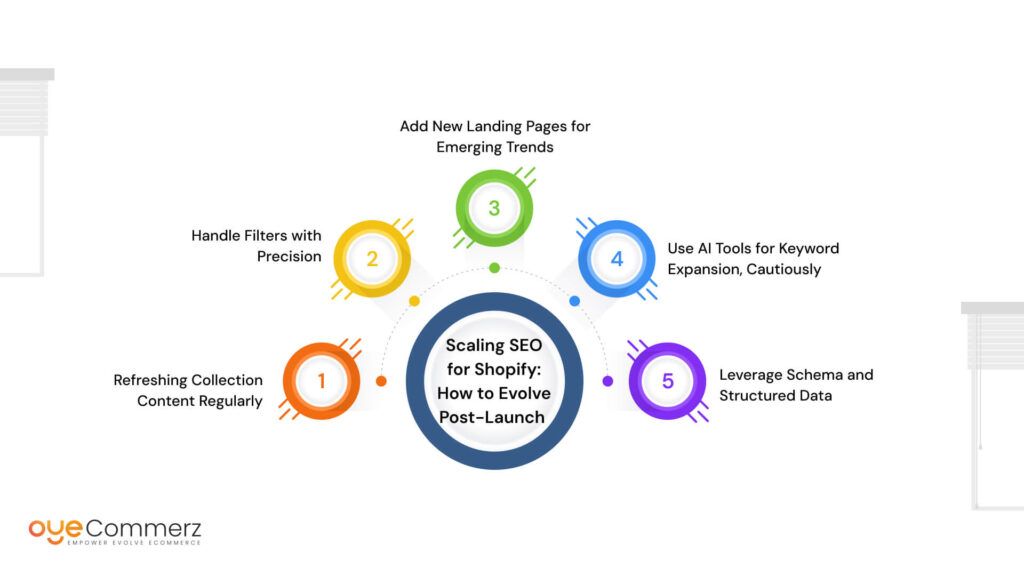
SEO isn’t a set-it-and-forget-it tactic, especially not on Shopify. Post-launch, many store owners make the mistake of maintaining their Keyword-First Store Creation without evolving it. To stay ahead, your SEO needs to scale with your business.
Refreshing Collection Content Regularly
Google rewards freshness. Use Google Search Console to:
- Identify declining impressions or CTRs
- Update meta titles, descriptions, and on-page copy every 3–6 months
- Add FAQs or related blog links to keep content dynamic
This ensures that your Shopify SEO strategy adapts to user behavior and search intent over time.
Handle Filters with Precision
Shopify’s collection filters (e.g., by color, size) can unintentionally create thousands of low-value, duplicate pages.
To avoid index bloat:
- Use canonical tags to point back to primary collection URLs
- Add noindex rules via robots.txt for irrelevant filter combinations
- Monitor crawl stats in GSC to detect indexing issues early
Add New Landing Pages for Emerging Trends
Search trends shift. Monitor rising topics in your niche and:
- Create blog posts to test keyword viability
- Turn high-performing blog topics into permanent collection or product pages
- Link back internally to build authority
This helps you expand without diluting your original breaking down the SEO risks foundation.
Use AI Tools for Keyword Expansion, Cautiously
AI can speed up content ideation, but:
- Never publish AI-generated content without manual review
- Use tools like ChatGPT or Jasper to surface long-tail opportunities
- Combine AI insights with real keyword performance data for precision
Leverage Schema and Structured Data
Shopify apps like JSON-LD for SEO or Smart SEO:
- Add product markup for ratings, pricing, and availability
- Help Google display rich results in SERPs
- Improve visibility on both desktop and mobile
Scaling SEO post-launch is all about iteration, intent, and insight, not automation overload.
Ready to Level Up your SEO Journey?
If you’re serious about growing your brand the smart way, our expert Shopify services are designed to support every stage of your SEO journey. From keyword mapping to rich snippets, we handle the technical and the tactical.
Don’t just rank, rank right. Let OyeCommerz help you avoid the SEO trap most Shopify brands are walking into.
Contact to Migrate your Site to Shopify Now
Conclusion
Keyword-First Store Creation isn’t the enemy, it’s the execution that determines success or failure. When applied with clarity, intent, and alignment with user experience, it can be a true growth lever. But when misused, it leads to broken journeys, poor engagement, and disappointing rankings.
Too many sellers fall into the trap of chasing high-volume phrases while ignoring what makes people convert: trust, relevance, and usability. That’s where real strategy comes in, understanding your market, mapping their journey, and delivering content that speaks to intent at every stage.
Shopify is incredibly capable from an SEO standpoint, but only if you respect its structure. Strategic use of collections, product pages, and supporting content must go hand-in-hand with your Shopify SEO strategy.
Breaking down the SEO risks means understanding them, not avoiding them. Build for humans first, search engines second. That’s how modern Shopify brands win the long game.
Frequently Asked Questions
Store SEO is the process of optimizing your online store to rank higher on search engines, attract organic traffic, and increase sales.
Keyword position refers to the rank your webpage holds on search engine results for a specific keyword.
Identify your target audience, research using tools like Google Keyword Planner or Ubersuggest, and choose relevant, high-traffic, low-competition terms.
A good keyword is relevant to your content, has high search volume, and low to medium competition.
Use keyword research tools, analyze competitors, include variations (short/long-tail), and group them by topic or intent.



